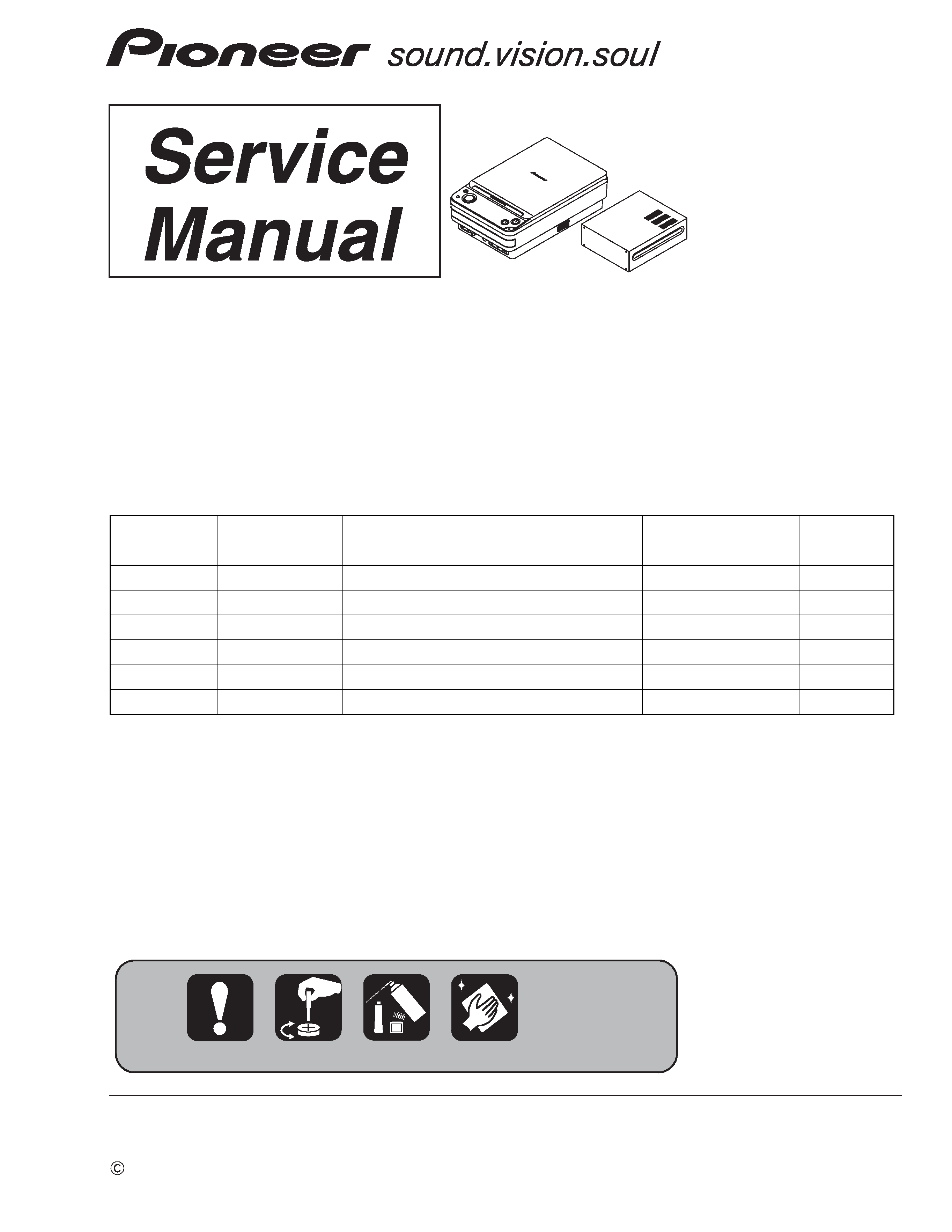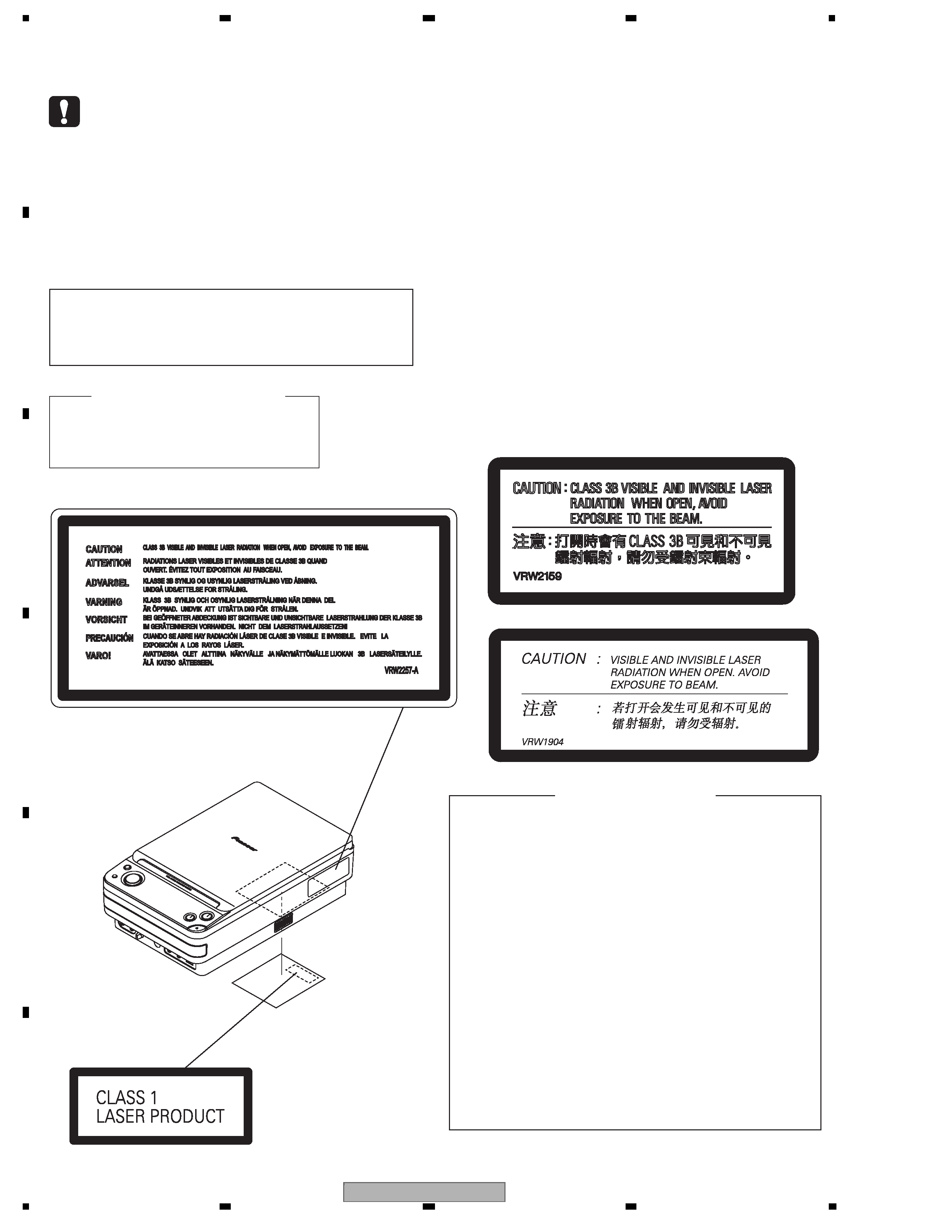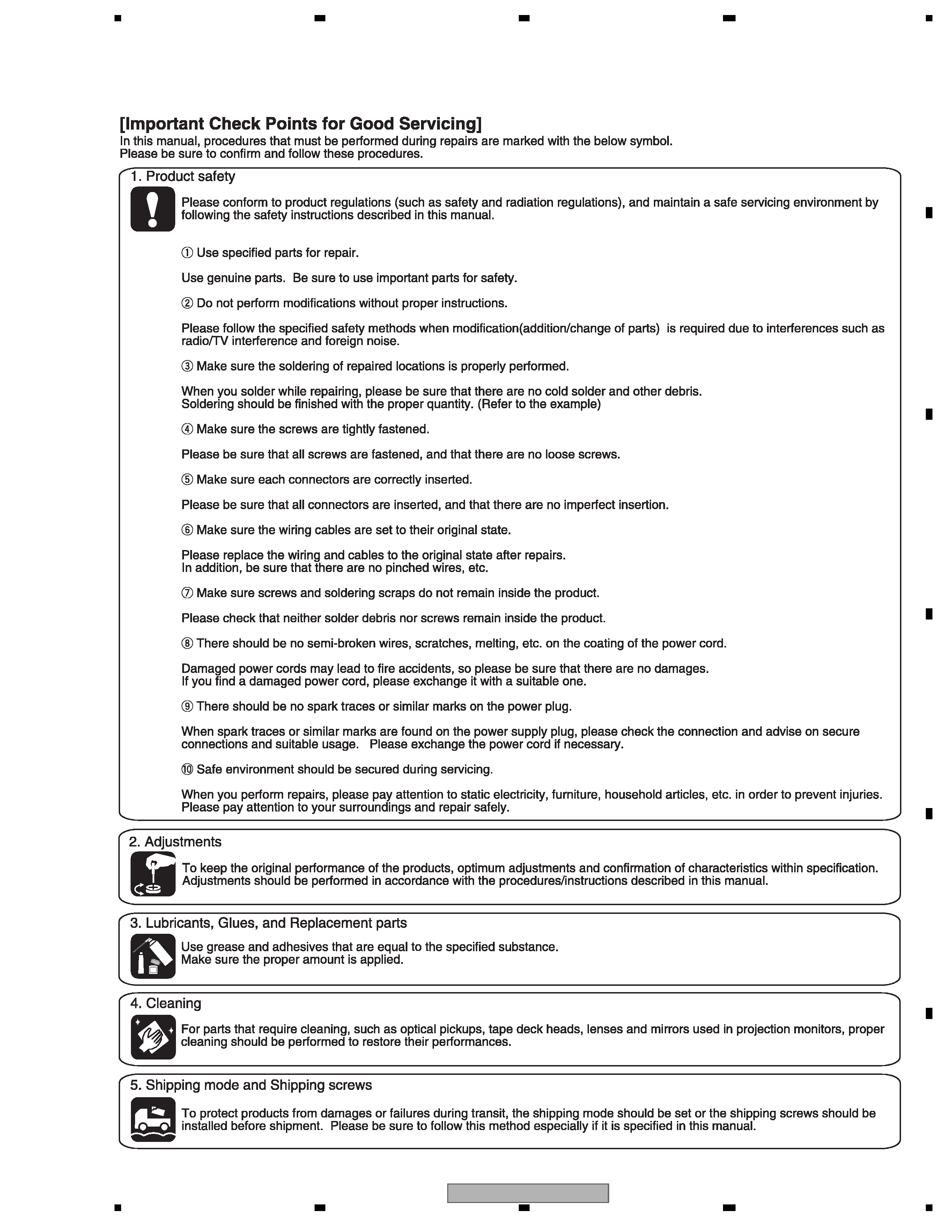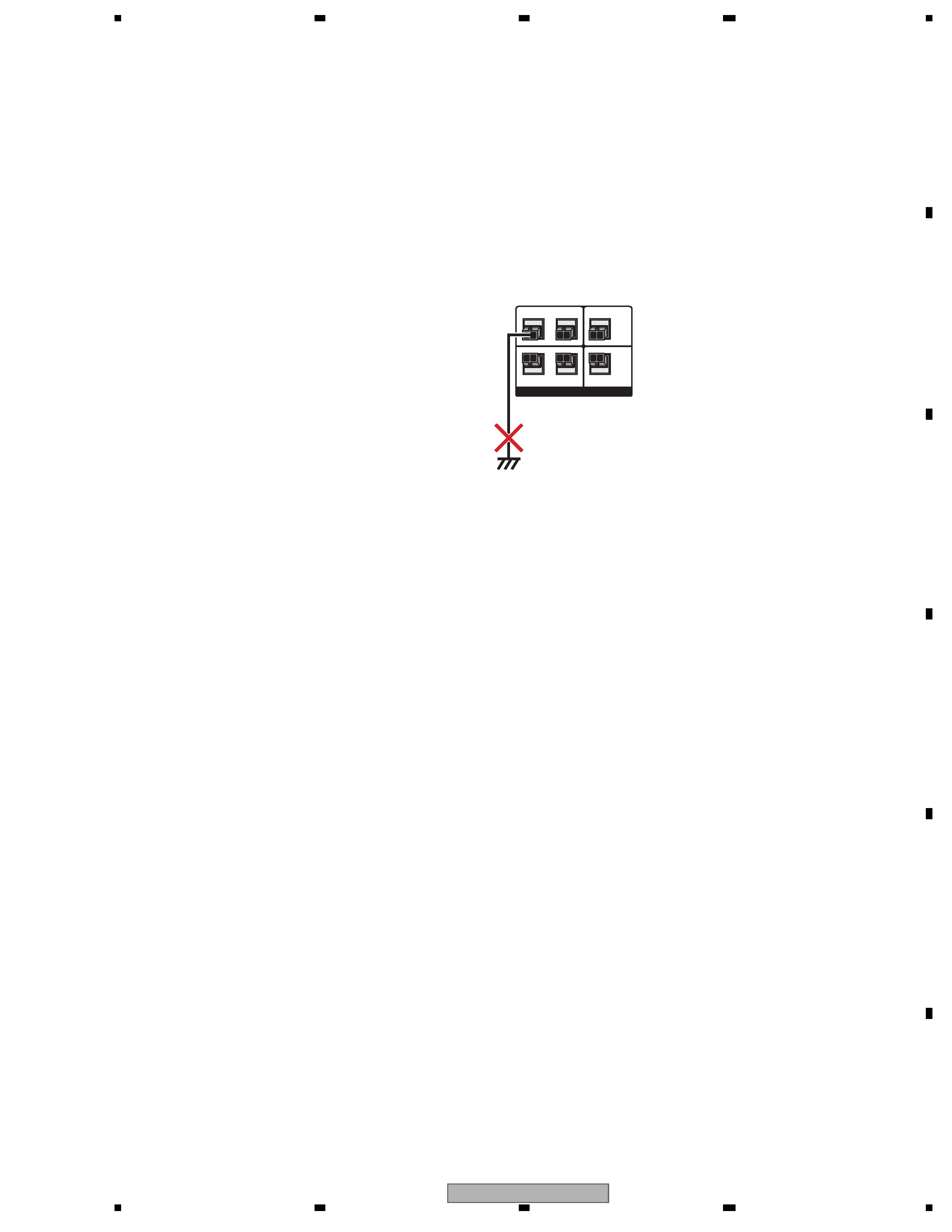
ORDER NO.
PIONEER CORPORATION 4-1, Meguro 1-chome, Meguro-ku, Tokyo 153-8654, Japan
PIONEER ELECTRONICS (USA) INC. P.O. Box 1760, Long Beach, CA 90801-1760, U.S.A.
PIONEER EUROPE NV Haven 1087, Keetberglaan 1, 9120 Melsele, Belgium
PIONEER ELECTRONICS ASIACENTRE PTE. LTD. 253 Alexandra Road, #04-01, Singapore 159936
PIONEER CORPORATION 2007
XV-CX505
RRV3646
DVD/CD RECEIVER
XV-CX505
THIS MANUAL IS APPLICABLE TO THE FOLLOWING MODEL(S) AND TYPE(S).
Model
Type
Power Requirement
Regional restriction
codes (Region No.)
Remarks
XV-CX505
GFXJ
AC 110 V to 220 V
3
XV-CX505
NAXJ5
AC 220 V
6
XV-CX505
NTXJ
AC 220 V
3
XV-CX505
TDXJ/RB
AC 110 V to 240 V
2
XV-CX505
WLXJ
AC 220 V to 240 V
3
XV-CX505
GXJ/RDDF
AC 110 V to 220 V
4
For details, refer to "Important Check Points for good servicing".
T-FZK AUG. 2007 printed in Japan

XV-CX505
2
12
34
1
234
C
D
F
A
B
E
SAFETY INFORMATION
LASER DIODE CHARACTERISTICS
FOR DVD : MAXIMUM OUTPUT POWER : 5 mW
WAVELENGTH : 650 nm
FOR CD :
MAXIMUM OUTPUT POWER : 7 mW
WAVELENGTH : 780 nm
Additional Laser Caution
1. Laser Interlock Mechanism
· Loading switch (S101 on the LOAB Assy) is used for interlock
mechanism of the laser.
When this switch turned ON in SW2 (CLOSE) side (OPEN signal is
0 V and CLOSE signal is 3.5 V), a laser becomes the status which
can completely oscillation.
Furthermore, the laser completely oscillates in the disc judgment and
disc playback.
When player is power ON state and laser diode is not completely
oscillating, 780 nm laser diode is always oscillating by half power.
· Laser diode is driving with Q307 (650 nm LD) and Q308 (780 nm
LD) on the DVD MAIN Assy.
Therefore, when short-circuit between the emitter and collector of these
transistors or the base voltage is supplied for transistors turn on, the
laser oscillates. (failure mode)
· In the test mode
, there is the mode that the laser oscillates except
for the disc judgment and playback. LD ON mode in the test mode
oscillates with the laser forcibly.
The interlock mechanism mentioned above becomes invalid in this
mode.
2. When the cover is open, close viewing through the objective lens with
the naked eye will cause exposure to the laser beam.
LABEL CHECK
: Refer to page 24.
This service manual is intended for qualified service technicians ; it is not meant for the casual do-
it-yourselfer. Qualified technicians have the necessary test equipment and tools, and have been
trained to properly and safely repair complex products such as those covered by this manual.
Improperly performed repairs can adversely affect the safety and reliability of the product and may
void the warranty. If you are not qualified to perform the repair of this product properly and safely,
you should not risk trying to do so and refer the repair to a qualified service technician.
WARNING!
The laser component is capable of emitting radiation exceeding
the limit for CLASS 1. A specially instructed person should do
servicing operation of the apparatus.
XV-CX505/WLXJ, NTXJ, TDXJ/RB and
GXJ/RDDF : VRW2257
Name Label
XV-CX505/GFXJ : VRW2159
XV-CX505/NAXJ5: VRW1904

XV-CX505
3
56
7
8
56
7
8
C
D
F
A
B
E

XV-CX505
4
12
34
1
234
C
D
F
A
B
E
CONTENTS
SAFETY INFORMATION ..................................................................................................................................... 2
1. SERVICE PRECAUTIONS ............................................................................................................................... 5
2. SPECIFICATIONS ............................................................................................................................................ 6
2.1 SPECIFICATIONS and ACCESORRIES ................................................................................................... 6
2.2 PANEL FACILITIES .................................................................................................................................... 8
3. BASIC ITEMS FOR SERVICE........................................................................................................................ 10
3.1 CHECK POINTS AFTER SERVICING..................................................................................................... 10
3.2 PCB LOCATIONS .................................................................................................................................... 11
3.3 JIGS LIST ................................................................................................................................................ 12
3.4 CLEANING............................................................................................................................................... 12
4. BLOCK DIAGRAM.......................................................................................................................................... 14
4.1 OVERALL WIRING CONNECTION DIAGRAM and LOAB ASSY ........................................................... 14
4.2 OVERALL BLOCK DIAGRAM.................................................................................................................. 16
5. DIAGNOSIS.................................................................................................................................................... 18
5.1 METHOD FOR DIAGNOSING DEGRADATION OF THE LDS ON THE PICKUP ................................... 18
5.2 DVD TROUBLE SHOOTING.................................................................................................................... 19
5.3 CIRCUIT DESCRIPTION OF DIGITAL AMP. SECTION .......................................................................... 22
5.4 SPECIFICATIONS FOR THE PROTECTION CIRCUITS FOR THE DIGITAL AMPLIFIER ..................... 23
6. SERVICE MODE ............................................................................................................................................ 24
6.1 TEST MODE ............................................................................................................................................ 24
6.2 DISPLAY SPECIFICATION OF THE TEST MODE .................................................................................. 25
6.3 FUNCTIONAL SPECIFICATION OF THE SHORTCUT KEY................................................................... 26
6.4 SPECIFICATION OF MODEL INFORMATION DISPLAY......................................................................... 27
6.5 FUNCTIONAL SPECIFICATION OF THE SERVICE MODE ................................................................... 28
6.6 SERVICE TEST MODE ........................................................................................................................... 29
7. DISASSEMBLY............................................................................................................................................... 32
8. EACH SETTING AND ADJUSTMENT ........................................................................................................... 43
8.1 ADJUSTMENT ......................................................................................................................................... 43
8.2 ID NUMBER AND ID DATA SETTING...................................................................................................... 48
9. EXPLODED VIEWS AND PARTS LIST.......................................................................................................... 52
9.1 PACKING SECTION ................................................................................................................................ 52
9.2 MAIN UNIT SECTION.............................................................................................................................. 54
9.3 POWER UNIT SECTION ......................................................................................................................... 56
9.4 06 LOADER ASSY................................................................................................................................... 58
9.5 TRAVERSE MECHANISM ASSY-S ......................................................................................................... 60
10. SCHEMATIC DIAGRAM ............................................................................................................................... 62
10.1 DVD MAIN ASSY (1/5)........................................................................................................................... 62
10.2 DVD MAIN ASSY (2/5)........................................................................................................................... 64
10.3 DVD MAIN ASSY (3/5)........................................................................................................................... 66
10.4 DVD MAIN ASSY (4/5)........................................................................................................................... 68
10.5 DVD MAIN ASSY (5/5)........................................................................................................................... 70
10.6 HAMP ASSY (1/2).................................................................................................................................. 72
10.7 HAMP ASSY (2/2).................................................................................................................................. 74
10.8 DISPLAY ASSY...................................................................................................................................... 76
10.9 HP/MIC, REGULATOR TRADE and DVD TRADE ASSYS .................................................................... 78
10.10 POWER SUPPLY UNIT........................................................................................................................ 80
10.11 WAVEFORMS ...................................................................................................................................... 82
11. PCB CONNECTION DIAGRAM ................................................................................................................... 84
11.1 LOAB ASSY ........................................................................................................................................... 84
11.2 POWER SUPPLY UNIT.......................................................................................................................... 85
11.3 DVD MAIN ASSY ................................................................................................................................... 86
11.4 HAMP ASSY .......................................................................................................................................... 90
11.5 DISPLAY, HP/MIC, DVD TRADE and REGULATOR TRADE ASSYS.................................................... 92
12. PCB PARTS LIST ......................................................................................................................................... 96

XV-CX505
5
56
7
8
56
7
8
C
D
F
A
B
E
1. SERVICE PRECAUTIONS
CAUTION
Ask users to bring both MAIN UNIT and POWER SUPPLY UNIT together when servicing.
NOTES ON BTL DRIVE
NOTES ON SOLDERING
SURROUND
SUB WOOFER
CENTER
FRONT
SPEAKERS (4
)
R
L
R
L
As a signal to drive the BTL is output from the negative speaker terminal, DO NOT short-circuit between the
negative speaker terminal and ground, such as the chassis.
Do not short-circuit between the plus speaker terminal and ground, such as the chassis, too.
Negative Speaker Terminal
Ground (Chassis)
Do not short-circuit
· For environmental protection, lead-free solder is used on the printed circuit boards mounted in this unit.
Be sure to use lead-free solder and a soldering iron that can meet specifications for use with lead-free solders for repairs
accompanied by reworking of soldering.
· Compared with conventional eutectic solders, lead-free solders have higher melting points, by approximately 40
°C.
Therefore, for lead-free soldering, the tip temperature of a soldering iron must be set to around 373
°C in general, although
the temperature depends on the heat capacity of the PC board on which reworking is required and the weight of the tip of
the soldering iron.
Do NOT use a soldering iron whose tip temperature cannot be controlled.
Compared with eutectic solders, lead-free solders have higher bond strengths but slower wetting times and higher melting
temperatures (hard to melt/easy to harden).
The following lead-free solders are available as service parts:
· Parts numbers of lead-free solder:
GYP1006 1.0 in dia.
GYP1007 0.6 in dia.
GYP1008 0.3 in dia.
